| ENVIS Technical Report: 90, April 2015 |
1Energy and Wetlands Research Group, Centre for Ecological Sciences,
2Centre for Sustainable Technologies (astra)
3 Centre for infrastructure, Sustainable Transportation and Urban Planning [CiSTUP],
Indian Institute of Science, Bangalore, Karnataka, 560 012, India
Web: http://ces.iisc.ac.in/energy
E Mail: cestvr@ces.iisc.ac.in; ganesh@ces.iisc.ac.in
Tel: 91-080-22933099, 2293 3503 extn 101, 107, 114
4Adamya Chetana, Annapoorna - Bangalore, Community Hall,
Kempegowda Nagar, Bengaluru, Karnataka 560019
Tel: 080 2662 0404, E Mail: tejaswini.acf@gmail.com
5
R K Mission, Shivanahalli, Anekal, Bangalore,
E Mail: vishnumayananda@gmail.com
*Corresponding author: cestvr@ces.iisc.ac.in
|
|
|

Tree planting
Avenue Trees (Saalu Mara) |
Species |
Common Name |
Preferred location |
Benefits |
Pongamia pinnata |
(Honge Mara) |
Open land and road side |
Gives shade and biodiesel production |
Artocarpus heterophyllus |
jackfruit |
Near homes |
Fruits bearing evergreen tree |
Mangifera indica |
Mango trees |
Near homes |
Fruits bearing evergreen tree |
Syzigium cumini |
Jamoon |
Open land and road side |
Fruits bearing evergreen tree |
Azadirachta indica |
Neem |
Open land and road side |
Medicinal value and act as dust barrier |
Ficus bengalensis |
Banyan |
Common places or near temple |
Give fruits throughout year and Has religious importance |
Ficus religiosa |
Sacred Fig, Peepal tree |
Common places or near temple |
Has religious importance |
Michelia champaca |
Champak |
Open land, Common places and road side |
Gives shade and flower |
Ficus racemosa |
Atti |
Open land and road side |
Fruits throughout the year |
Bombax malabaricum |
Silk Cotton |
Open land and road side |
Cotton can be extracted and used |
Tamarindus indica |
Tamarind |
Open land and road side |
Fruits have high market value |
Prosopis cineraria |
Banni Tree |
Open land and for fencing fields |
Religious importance and biomass |
Murraya koenigii |
Curry leaf tree |
Near homes |
Medicinal value and used for cooking |
Maintenance cost:
- Each sapling need 2ft X 2ft width, 2ft depth pit.
- Minimum distance between 2 saplings is 15 to 20 feet.
- Digging pits, providing manure, planting and closing the pit costs: Rs. 200 per plant
- Tree guard using natural material like bamboo and thorns costs: Rs. 100 per plant; Using metal tree guard for 5 feet costs: Rs. 1,000 per plants.
- Maintenance for 3 years costs Rs. 400 per plant.
- Regular watering the sapling during first year
- Watering once in 2-3 days in the 2nd and 3rd year
Sapling |
Rs 200-400 per sapling |
Digging and planting |
Rs 200 per sapling |
Tree guard |
Rs 100 per tree |
Number of avenue trees |
40-50 trees per km per side |
Maintenance cost (watering, labour, etc.) |
Rs. 150 per sapling during the first year
Rs. 100 per sapling during the second year |

Figure 1: Major road network
Energy Plantation |
Species |
Common Name |
Benefits |
Pongamia pinnata |
Honge Mara |
Biodiesel production |
Jatropha curcas |
Jatropa |
Biodiesel production |
Leucaena leucocephala |
Subabul |
Higher biomass yield and fixes nitrogen |
Vachellia nilotica |
Acacia nilotica, gum arabic tree |
Higher biomass yield and used as forage |
Fodder Plantation |
Leucaena leucocephala |
Subabul |
Legume provides high-protein cattle fodder |
Acrocarpus fraxinifolius |
Belangi, Hantige |
The foliage is used as fodder and the flowers are a source of nectar for honey bees |
Pennisetum purpureum |
Napier grass or Elephant grass |
Higher productivity and generally grown in all region. |
Dichanthium annulatum |
Karad grass |
It is a perineal grass and can be used for field grazing. Cattle find it palatable. |
Macrotyloma uniflorum |
Horse gram |
Seeds of horse gram are generally utilised as cattle feed. It also famous for its medicinal properties. |
Cenchrus ciliaris |
Anjan grass |
It’s a perineal grass which also reduces soil erosion. |
Eco Sanitation
Design Details |
Specifications |
No. of users |
5 |
Average volume of desiccated material |
0.25 litres / person / day |
Toilet size (floor area) |
1.5 m width x 1.2 m length |
Soak pit |
2.25 m x 2.25 m x 2.25 m size |
Soak pit life |
5 years |
Door |
0.90 m x 2.1 m |
Roof |
1–2" thick ferro-cement slab or AC/GI sheets |
Structure (permanent) |
Brick wall 115 mm thick |
Cost |
Rs. 10,000 to 20,000 |
Cost Estimation
The cost of a household eco-friendly toilet depends on factors like quality and type of material used, number of chambers opted (one or two), thickness of walls, finishing of the toilet unit, urine diverting pan opted and other amenities such as doors and ventilators. The cost of a household toilets built expected to range between Rs 10,000 to Rs 20,000 given the current market price of the materials and labour across India.
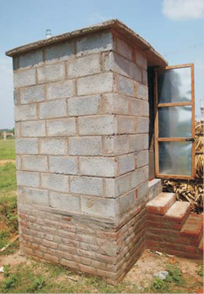
|
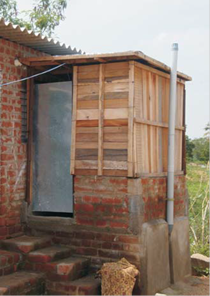
|
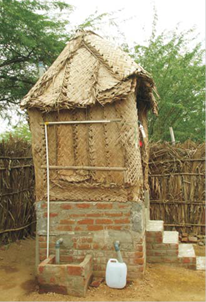
|
Brick Walll |
Waste wood/Bamboo |
Coconut thatch |
Community Biogas plant
Design details |
Specifications |
Input/Feed |
100 Kg of kitchen waste/cow dung/organic matter per day |
Area required |
50 m2 |
System equipment |
Main Digester, Pre-Digester, Gas Holder, Intermediate chambers, Slurry Tank, Gas flow pipe line, Moisture trap systems, Slurry pump, crusher, Air Compressor, Bio-Gas Burner |
Biogas generation |
Generation of biogas per day |
6 m3 |
LPG Equivalent of biogas |
2.4 Kg/day |
Savings through LPG per day (@Rs 63/Kg) |
151 Rs/day |
Manure production per day |
10 Kg |
Commissioning organisation |
NIE-CREST, NIE, Mysore - 570008, Karnataka, India, Ph:0821-4004914 Technology: BARC, Mumbai |
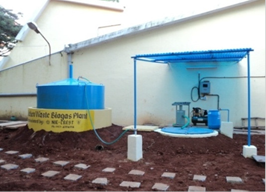
|
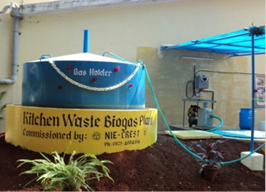
|
Community Solar Water Heater
|
Specifications |
Comments |
No. of water heating and distributing units |
Minimum one unit for 20 homes with two outlets |
|
Water distribution |
15 litres per person per day |
Charge of 1Rs per bucket (of 12 litters) would generate the revenue |
Cost of water |
INR 3 for first 15 lt.
INR 2 for every extra 5 lt. |
|
Human resource requirement |
2 persons/unit |
In every village, 2 persons to take care of fee collection once in a week and maintain the register |
Operating time |
8.00 to 10.00 in the morning |
|
Fee collection |
Through swipe cards and money transfer once in a week |
|
Capacity |
1000 litres |
|
Collector area |
12 m2 |
Total area is about 20 m2 and the tank should be placed at least 4 to 5 feet above ground |
|
Dr. T.V. Ramachandra
Centre for Sustainable Technologies, Centre for infrastructure, Sustainable Transportation and Urban Planning (CiSTUP), Energy & Wetlands Research Group, Centre for Ecological Sciences, Indian Institute of Science, Bangalore – 560 012, INDIA.
E-mail : cestvr@ces.iisc.ac.in
Tel: 91-080-22933099/23600985,
Fax: 91-080-23601428/23600085
Web: http://ces.iisc.ac.in/energy
Ganesh HegdeEnergy & Wetlands Research Group, Centre for Ecological Sciences, Indian Institute of Science, Bangalore – 560 012, INDIA.
E-mail: ganesh@ces.iisc.ac.in
Subhash Chandran M.D.Energy & Wetlands Research Group, Centre for Ecological Sciences, Indian Institute of Science, Bangalore – 560 012, INDIA.
E-mail: mds@ces.iisc.ac.in
Tejaswini Ananth KumarAdamya Chetana, Annapoorna - Bangalore, Community Hall,
Kempegowda Nagar, Bengaluru, Karnataka 560019
E-mail: tejaswini.acf@gmail.com
Vishnumayananda SwamijiR K Mission, Shivanahalli, Anekal, Bangalore
E-mail: vishnumayananda@gmail.com
Citation:Ramachandra T V, Ganesh Hegde, Subash Chandran M D, Tejaswini Ananth Kumar and Vishnumayananda Swamiji, 2015., SMART Ragihalli: Effort towards Self-reliant & Self-sufficient system empowering Man power (rural youth) with Appropriate Rural Technologies,ETR 90, Energy & Wetlands Research Group, CES, Indian Institute of Science , Bangalore
| Contact Address : |
| |
Dr. T.V. Ramachandra
Energy & Wetlands Research Group,
Centre for Ecological Sciences, TE 15, New Biology Building, Third Floor, E Wing, [Near D Gate], Indian Institute of Science, Bangalore – 560 012, INDIA.
Tel : 91-80-22933099 / 22933503-extn 107
Fax : 91-80-23601428 / 23600085 / 23600683 [CES-TVR]
E-mail : cestvr@ces.iisc.ac.in, energy@ces.iisc.ac.in,
Web : http://wgbis.ces.iisc.ac.in/energy |
| |








